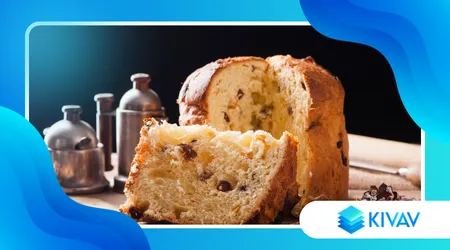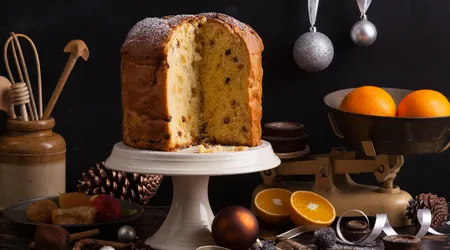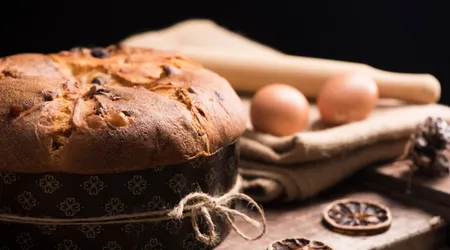Original recipe for Milanese panettone

The Milanese panettone It's more than a Christmas dessert: it's a symbol of Milan, a warm embrace of tradition that unites generations.
Announcements
Born between legends and artisanal wisdom, this leavened cake embodies Italian excellence, with its golden dome and a soft heart of raisins and candied fruit.
In 2025, the Milanese panettone It is experiencing a renaissance, celebrated by innovative pastry chefs and families who are rediscovering the joy of making it at home.
In this article, we'll explore the authentic recipe, the secrets of leavening, and its cultural significance, offering practical advice and a glimpse into the present.
Why the Milanese panettone It's not just food, but living history, capable of telling the story of Italy with every bite.
Announcements
The Legendary Origins of Milanese Panettone
A fascinating story surrounds the Milanese panettone, intertwined with myths and truths.
The best-known legend tells of Toni, a scullery boy at the court of Ludovico il Moro, who saved a Christmas banquet by improvising a dessert with leftovers: flour, butter, eggs, raisins and candied fruit.
Thus was born the “pan di Toni”, the forerunner of the Milanese panettoneAlthough romantic, this story clashes with historical documents: as early as 1599, the Borromeo College of Pavia recorded “large breads” with butter and raisins for Christmas.
The tradition was consolidated in the 19th century, when the recipe took on modern features. In 1853, Giovanni Felice Luraschi codified the "pasta per far panatoni," a step toward standardization.
Milan, the cradle of the dessert, made it a global icon, thanks also to pastry chefs like Angelo Motta, who introduced the tall, domed shape in the 1920s.
++ Cantucci biscuits with almonds
Today, the Milanese panettone It is protected by a 2005 specification, which defines its ingredients and artisanal methods.
This rigor guarantees authenticity, distinguishing the real panettone from industrial imitations.
Its history, however, is not static: it evolves with new interpretations, while remaining anchored to tradition.

Ingredients: The Heart of the Traditional Recipe
The magic of the Milanese panettone lies in the simplicity of its ingredients, transformed by a long artisanal process.
Strong flour, quality butter, fresh eggs, sugar, sourdough starter, raisins, candied orange and citron peel, vanilla: every element is essential.
See also: Grandma's Cake: Cream and Pine Nuts
The specifications require minimum percentages, such as 20% of raisins and candied fruit, to ensure aromatic richness.
| Ingredient | Quantity (per 1 kg) | Notes |
|---|---|---|
| Strong flour | 500 g | W 350-400, to support leavening |
| Mother yeast | 150 g | Refreshed at least 3 times |
| Butter | 200 g | Soft, high quality |
| Egg yolks | 100 g | Fresh, at room temperature |
| Sugar | 150 g | Balance sweetness and conservation |
| Raisins | 150 g | Soaked and squeezed |
| Candied fruit | 100 g | Orange and citron, cut evenly |
| Vanilla | 1 pod | Seeds extracted for intense aroma |
The choice of ingredients is uncompromising. For example, the butter must be soft but not melted, for an elastic dough.
The raisins, soaked for hours, give softness, while the candied fruit, often divisive, is the distinctive touch of the Milanese panettone.
In 2025, Milanese pastry chefs are experimenting with candied exotic fruits or local varieties, but the specifications remain a guiding principle.
Making panettone at home requires fresh ingredients and patience, but the result repays every effort with an intoxicating aroma.
The Artisan Process: Patience and Precision
Create a Milanese panettone It's an art that takes days, not hours. The sourdough starter, the beating heart, must be refreshed three times before use, ensuring strength and aroma.
The dough, worked in two phases, rises for 12-15 hours, tripling in volume in a warm environment (28-30°C).
After the first leavening, raisins and candied fruit are added, carefully incorporated for even distribution.
The dough rests for another 6-8 hours in baking cups, before being cut into a cross and baked at 180°C for about 50 minutes. Cooling the panettone upside down, suspended, prevents it from collapsing.
This process, codified by the “Committee of Milanese Master Pastry Chefs”, distinguishes artisanal panettone from industrial ones.
In 2025, online courses and workshops in Milan will teach these techniques, making the tradition accessible to all.
The analogy is clear: making panettone is like painting a picture. Every brushstroke, every leavening, creates a unique work, where time is your best ally.
Milanese Panettone in 2025: Tradition and Innovation
The Milanese panettone It's not stuck in the past. In 2025, Milanese pastry chefs are pushing boundaries without betraying their roots.
Pastries like Pasticceria Martesana offer variations with dark chocolate or marron glacé, while still respecting the specifications.
According to a report by Vanity Fair Italia, 50 top artisanal panettone cakes were sold in 2024, a sign of growing demand.
Italian families are rediscovering DIY, with products like those from Dolci&Pani that simplify the recipe.
Events like “Re Panettone” in Milan celebrate the sweet treat with tastings and competitions between master pastry chefs.
Have you ever tried making panettone? It's an experience that connects you to the heart of Milan, a journey into tradition that feels like home.
Practical Examples for a Perfect Panettone
Do you want to prepare a Milanese panettone At home?
Here are two practical examples. First: the aromatic mix. Grate orange and lemon zest, add vanilla seeds and a tablespoon of honey.
Let it rest for 12 hours for an intense aroma. Second: the rounding. After the first rise, round the dough with circular movements to compact it, ensuring a high dome.
These measures, inspired by masters such as Iginio Massari, elevate the result.
Use a stand mixer to knead the dough and monitor the temperature: the dough should not exceed 26°C.
By 2025, tutorials on platforms like Acadèmia.tv offer step-by-step demonstrations, making the recipe accessible even to beginners.

The Cultural Value of Milanese Panettone
Beyond the flavor, the Milanese panettone It's a ritual. In Milan, the tradition of saving a slice for San Biagio (February 3) persists, a propitiatory gesture against ailments.
This dessert brings families together, evoking memories of Christmases past.
Exported to South America and beyond, panettone is now global, but its soul remains Milanese.
In 2025, initiatives like "Galup che Goal!" in Pinerolo promote solidarity through sweets, demonstrating their unifying power.
Making it at home is an act of love, a way to pass on stories and flavors. It's a bridge between past and future, a dessert that speaks to us.
Conclusion: A Dessert That Tells the Story of Milan
The Milanese panettone It's not just a dessert, but a story of Milan, made of legends, flavors, and dedication.
In 2025, its original recipe lives on in historic pastry shops and home kitchens, combining tradition and innovation.
Preparing it is a journey that takes time, but it offers unique emotions: the aroma that fills the house, the dome rising in the oven, the first soft bite.
Whether you are a purist or an innovator, the Milanese panettone invites you to celebrate life, slice by slice.
Gather your ingredients, turn on the oven, and let yourself be guided by the magic of this Italian masterpiece. Merry Christmas, wherever you are, and bon appetit!
Frequently Asked Questions
1. Can I use brewer's yeast instead of sourdough starter?
Yes, but sourdough starter provides better flavor and keeps better. Use 25 g of brewer's yeast per 500 g of flour, reducing the rising time.
2. How do I store panettone?
Wrap it in plastic wrap and store it in a cool, dry place. It can last up to 15 days, maintaining its softness and flavor.
3. Can I omit the candied fruit?
Yes, substitute with chocolate chips or dried fruit, but candied fruit is traditional and balances the sweetness.
4. Why should panettone be cooled upside down?
To prevent it from collapsing, maintain its soft structure. Use irons or skewers to suspend it while it cools.
5. What is the best flour?
Use a strong flour (W 350-400), such as Manitoba, to support the rich dough and ensure optimal leavening.
